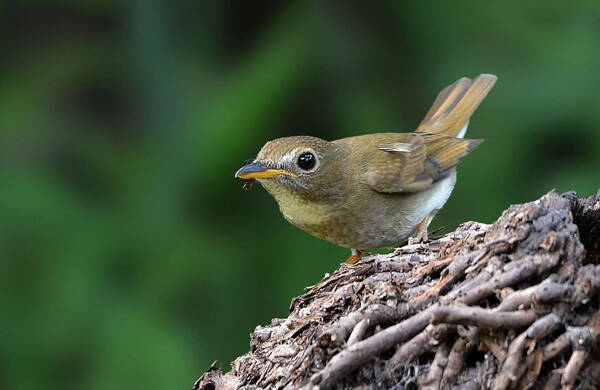Rhinomyias brunneatus
IUCN
LCBasic Information
Scientific classification
- name:Rhinomyias brunneatus
- Scientific Name:White-gorgetted Jungle Flycatcer,Rhinomyias brunneatus,Rhinomyias brunneata
- Outline:Songbird
- Family:Passeriformes F.family Flycatcher
Vital signs
- length:About 15 cm
- Weight:10-15g
- lifetime:No verification information
Feature
The eye circles are yellow; the wings and back are the same color, the first primary flight feather is very long, not shorter than half of the second one
Distribution and Habitat
The white-throated flycatcher is distributed in China, Malaysia, Singapore, Thailand, and Brunei (uncertain). [5] In China, it is mainly distributed in Henan, Sichuan, Yunnan, Hubei, Hunan, Jiangsu, Jiangxi, Zhejiang, Fujian, Taiwan, Guangdong, Guangxi, and Hong Kong.
The white-throated flycatcher inhabits the understory of forest edges, dense bamboo thickets, secondary forests, and artificial forests up to 1,100 meters above sea level.
Appearance
The male and female white-throated flycatchers are the same color. They are medium-sized, 150 mm long, brownish in color, with yellowish eye circles and light brown breast bands. The wings are the same color as the back, and the first primary flight feather is particularly long, not shorter than half the length of the second one. The throat is white, the neck is nearly white with slightly dark scaly markings, and the lower jaw is light in color. The chest is light brown-gray; the abdomen and undertail coverts are white. The upper body of the sub-adult bird is yellowish with scaly markings, and the tip of the lower jaw is black. It looks like it has short wings and a long beak.
The iris is brown; the upper jaw of the beak is nearly black, and the base of the lower jaw is yellowish; the feet are pink or yellow.
Details
White-throated Jungle Flycatcer is also known as White-gorgetted Jungle Flycatcer. It is a bird of the family Flycatcher and genus Jungle Flycatcher. Male and female birds are the same color and there is no subspecies.

The outer edge of the primary flight feathers of the White-throated Flycatcher is light in color, with an olive green back, a grayish-white abdomen, an olive green chest, and pink feet. The difference from the Brown-breasted Flycatcher (Muscicapa muttui) is that its back is olive green instead of brown, and the edge of the tertiary flight feathers is not obvious. The difference from the Northern Gray Flycatcher (Muscicapa dauurica) is that its individual is larger.
White-throated Flycatcher generally feeds on insects. It often stands on branches and waits quietly. Once a flying insect approaches, it will catch it and then return to its original place to roost. It weaves a bowl-shaped nest with moss, bark, hair, feathers, etc. on trees or in caves.
White-throated Flycatcher is a summer migratory bird in mainland China. Outside the breeding season, it appears in Thailand and is a rare migratory bird; it is a winter migratory bird in Peninsular Malaysia, and the population spends the winter in Peninsular Malaysia; Singapore is a rare migratory bird and winter migratory bird.
The song of the white-throated flycatcher is 5-11 times of an unequal frequency. The pattern is that it starts with 1-3 high-frequency "chi" sounds (6.10 kHz), followed by 2 low-frequency sounds (1.93 kHz), and finally 2-6 slightly higher-frequency sounds (2.28 kHz). The syllables are short, the tone is steady and single, and the timbre is like a flute.
The white-throated flycatcher breeds in southeastern mainland China. The breeding site is usually a dense bamboo forest or low bushes in a subtropical broad-leaved forest, at an altitude of 600-1600 meters. The number of eggs in a nest is mostly 4-5, and a few are only 1-2. The eggs are spotted. Both sexes have fertile cones.
Based on an assessment of known records and range size, the estimated number of mature individuals of the White-throated Flycatcher is between 2500 and 9999. This is consistent with recorded population density estimates for similar-sized birds or close relatives (which range from 10-90 individuals per square kilometer), and the estimated number of mature individuals may be a proportion of the total. This total estimate is 3750 to 14999 individuals, rounded to 3500 to 15000 (2016).
The White-throated Flycatcher is likely to experience rapid population declines across both its breeding and non-breeding ranges due to habitat loss and degradation. The requirement for mature native lowland forests in its wintering grounds in Southeast Asia suggests that this species may be particularly vulnerable to habitat loss, particularly expansion of cultivation at low altitudes.
The White-throated Flycatcher is threatened by continued habitat loss and fragmentation throughout its breeding and non-breeding ranges. In southeastern China, much of the natural forest has been cleared or improved through timber harvesting and agricultural land conversion. Lowland forests have been particularly affected. The White-throated Flycatcher's requirement for mature native lowland forests during the non-breeding season makes it particularly vulnerable to habitat loss, as few such forests remain today. Habitat degradation along migration routes can also be a problem. In some areas (e.g. Guangxi, China), the birds are captured for food.
Listed on the IUCN Red List of Threatened Species (IUCN) - Vulnerable (VU).
Listed in the "National List of Terrestrial Wildlife with Important Economic and Scientific Research Value" issued by the State Forestry Administration.
Listed in the second level of China's "National List of Key Protected Wildlife" (February 5, 2021).
Protect wildlife and eliminate game.
Maintaining ecological balance is everyone's responsibility!








